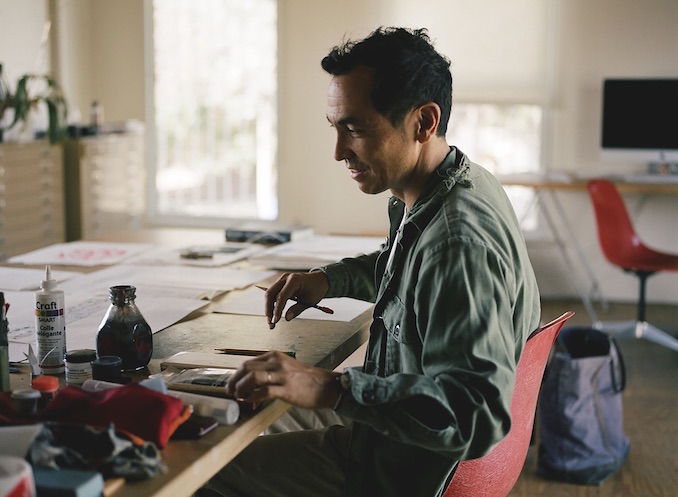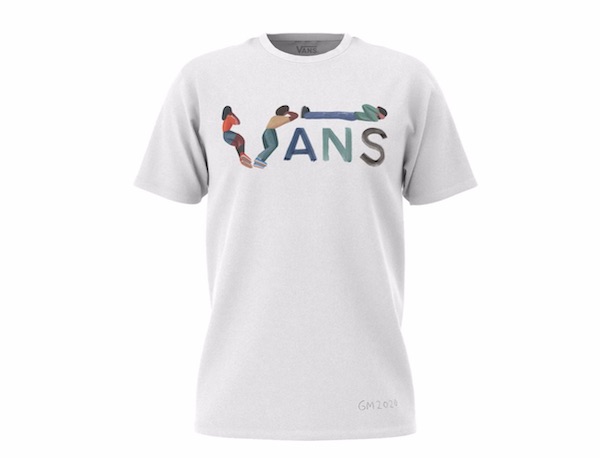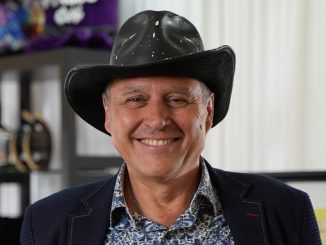It’s been a challenging year to say the least and we’re looking for ways uplifting and resourceful ways to raise awareness and resources for mental health and well-being particularly for the youth in our society. We are all affected these uncertain times but one thing we know is how important it is to continue to have creative outlets and the ability to express ourselves. Leading up to November 19, Vans Checkerboard Day, fans of the brand participated in a variety of global initiatives digitally including TikTok Challenges, tuning in to hear artists like Anderson, Paak, Yaya Zahir, among others talk about how their own forms of creative self-expression have helped them. Another initiative happening this month that caught our attention was a collab with renowned artist Geoff McFetridge.

McFetridge grew up in Calgary, Alberta and attended the Alberta College of Art. In 1994, he moved to California to attend Graduate school at the California Institute of the Arts (Cal Arts). “I was drawn to Cal Arts for the conceptual approach to design they were teaching, as well as the fact they were in Los Angeles… California =skateboarding + West Coast culture,” said McFetridge. “So, moving to LA was about design but also being in the place that I felt would feed what I thought was a new way to look at design. Design is highly personal and an expressive voice of culture.”
We had a chance to interview McFetridge to learn more about his work and how he’s involved in raising awareness about this global mental health issue in the youth today.
How did you get involved with Vans’ Checkerboard Day?
GM: I’ve worked with Vans closely for years. I’m a sort of a Vans Art Ambassador, which generally means helping Vans from the outside. Vans is involved in culture in many ways and I help to visually articulate some of those involvements. Last year, I was a part of Checkerboard Day in a small way by making custom products. This year is a much bigger commitment and I was honored that they asked me to be a part of it.
Can you tell us about your design inspo on the Vans Authentics & T-shirt this year?
GM: There was no brief or notes from Vans at all! I respond to most projects as extensions of what I’m doing in the painting studio. Last year, I created a pattern of simple heads – a sort of crowd – that was a sort of shoulder to shoulder human checkerboard.
This year, I painted a series of simplified people relaxing. This comes out of a series of works I’ve done during the pandemic. I think it came out of seeing people laying in the park, in small groups sleeping, or just connecting during this stressful time. Public relaxing is nice and nice to see. I think that human connection is the first step in battling many mental health struggles.
The people sort of nest together and seem to quietly connect with each other. But the subject matter almost ceases to matter; the figures have become a repository of intentions and the intentions are what is visible. My hope is these people, these figures, represent a rejection of the world’s nastiness… That the image feels like the product of compassion.

Your artwork uses simple forms yet when we are taking them in, we find they draw up emotions. Even the titles of your exhibitions really draw us in and encourage us to pause and think. The Quiet of Not Listening, It Looks Like It Says, My Head Disappears When My Hands Are Thinking are all encouraging of discussion. Are we overthinking them?
GM: Writing is a part of my process. Titles of works or shows come out of writing I do while conceiving works or, more often than not, are done after the show is finished as a last chance moment to bring something to the works. Writing is sometimes easier than images, but what I do relies on my ability to articulate with images what I cannot express through writing. The paintings are meant to be poetic, to work with visual language like a poet might arrange words. Just like the vocabulary of a poem should not get in the way of what it expresses, the subjects and images in my works are there to facilitate emotion and meaning.
Mental wellness is important especially during these months of social distancing, what have you found helpful?
GM: Regular exercise, in the outdoors every day. In variety. Contact with friends (from a distance, or on the phone), limiting use of Instagram and news exposure. If possible: sun! I also have a regular Transcendental Meditation practice (two 20-minute daily meditations.)
Vans talks about “smaller acts of expression” what does that mean to you?
GM: In life, if there was on a 1 to 10 scale and a 1 was “be nice to a stranger” and a 10 was “end all suffering”, I’d say keep doing 1s and maybe some 2s instead of simply pondering the 10s.
In skateboarding, don’t try to do a trick you used to be able to do; try a new trick that might be easier but you’ve never done before.
We’ve heard you have a skateboard company, but you also have your graphic arts also found on wallpaper and fabric. That’s quite a range and a different clientele or did they just grow up with you? How did the interior design aspect come about?
GM: The skateboard company was pretty grown-up and the wallpaper and fabric company (Pottok Prints) comes directly out of my art practice. My studio (Champion Graphics) and my design practice is about having an ability to work in many ways. I like that I can develop the work slowly over the years and change the work as my thinking changes. But then, how that work goes out in the world will be really varied.
Currently, you also have a solo exhibition happening at the V1 Gallery in Copenhagen. Can you tell us more about this exhibition?
GM: I’ve shown with V1 for many years. The show is titled These Times Are Nameless and that title comes out of this poem:
We filled the room
With what we thought would be most useful
The substance of living
It took the shape of the walls
And went to the height of the ceiling
Like a train that has grown to the length of its tracks
The works are very much a response to these times, but many came from drawings done months before COVID-19. The theme of “human connection” that’s in much of my work can also feel like a direct reflection on these times… And it is.
How has the pandemic impacted the gallery scene over there?
GM: People are still buying art, so that’s surprising. I’m unclear how many galleries will close for good or adapt into an unrecognizable form when this is over.
What words can offer to the younger population (or everyone) as we all experience and try to get through this pandemic together?
GM: I experienced the big Earthquake of ‘94. Cal Arts was very close to the epicenter. It was a life-altering experience for our class. It defined my time there. As we go through this, we’re all at the epicenter of the pandemic. This is something that’s connecting the whole world and that’s a powerful thing. The world is not-so-gently shaking us awake.
***
You can learn more ways to get creative for your own mental health while raising awareness here.
100% of sales from the limited-edition Vans Checkerboard Day T-shirt and pair of Authentics designed by Geoff McFetridge will be donated to The Vans Checkerboard Fund at Tides Foundation. Through their support of various charities, funds raised will be used to help improve the mental health and well-being of youth across the globe through creativity.




